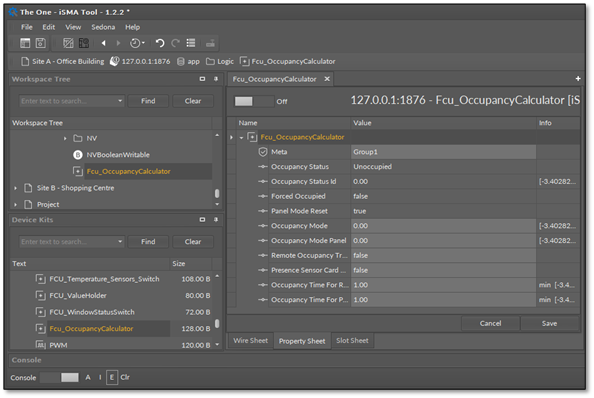FCU_OccupancyCalculator
The FCU_OccupancyCalculator component manages the occupancy status, depending on the occupancy data provided from the BMS system or remote devices such as room panels, presence sensors, or cardholders.

The FCU_OccupancyCalculator component has the following slots:
- Occupancy Status: shows the current occupancy status;
- Available information: (0) Unoccupied, (1) Occupied, (2) Standby;
- Occupancy Status Id: the output numeric value corresponding to the Occupancy Status slot;
- Forced Occupied: the binary output slot providing the information about the occupancy status source:
- True: the occupied mode has been forced, which means, that the component works in the occupied mode, but this mode has not been calculated according to the Occupancy Mode slot, only forced by the room panel (the Occupancy Mode Panel slot set to Occupied), presence sensor cardholder (detected rising edge on the Presence Sensor Card Holder slot), or by the remote trigger (detected rising edge on the Remote Occupancy Trigger slot);
- False: the occupied mode has not been forced;
- Panel Mode Reset: the binary output, resetting the value from a component connected to Occupancy Mode Panel slot after switching off the Occupancy Mode, which has been forced by the room panel. By default, the Panel Mode Reset slot is set to false. It is set to true for one application cycle if the time of the Occupancy mode forced by the room panel has passed;
- Occupancy Mode: the occupancy mode set from the higher-level system (for example, the panel dedicated to the iSMA-B-FCU device);
- Available information: (0) Unoccupied, (1) Occupied, (2) Standby;
- Occupancy Mode Panel: the occupancy mode set from an external source (for example, the iSMA-B-LP room panel);
- Available values: (0) Unoccupied, (1) Occupied;
Note: The value of the Occupancy Mode Panel slot allows to force the occupied mode from the room panel. If the Occupancy Mode slot is set to 0 or 2 (unoccupied or standby values), setting the value of the Occupancy Mode Panel slot to Occupied forces the occupied mode for the time defined in the Occupancy Time For Remote Trigger slot. During this time the Forced Occupied slot is set to true. After this time, the value of the Panel Mode Reset slot is set to true for one application cycle, and then component goes back to the previous occupancy mode. The occupied mode forced this way can be also cancelled by setting the Occupancy Mode Panel slot back to 0 (unoccupied).
- Remote Occupancy Trigger: the binary input slot, recommended for remote occupancy triggers, allows to force the occupied mode. If the Occupancy Mode slot is set to 0 or 2 (unoccupied or standby), the rising edge detected on this slot will force the occupied mode for the time defined in the Occupancy Time For Remote Trigger slot. The time countdown starts when a falling edge is detected in the Remote Occupancy Trigger slot. During this time, the Forced Occupied slot remains set to true. After this time, the component goes back to the previous occupancy mode. The occupied mode forced this way cannot be cancelled.
- Presence Sensor Card Holder: the binary input slot, recommended for presence sensors or cardholders, allows to force the occupied mode. If the Occupancy Mode slot is set to 0 or 2 (unoccupied or standby), the rising edge detected on this slot will force the occupied mode for the time defined in the Occupancy Time For Presence Sensor slot. The time countdown starts when a falling edge is detected in the Presence Sensor Card Holder slot. During this time, the Forced Occupied slot remains set to true. After this time, the component goes back to the previous occupancy mode. The occupied mode forced this way cannot be cancelled.
- Occupancy Time For Remote Trigger: the time for which the occupancy mode, forced by the room panel or remote trigger, is held once the falling edge is detected on the Remote Occupancy Trigger slot;
- Occupancy Time For Presence Sensor: the time for which the occupancy mode, forced by the presence sensor or cardholder, is once the falling edge is detected on the Presence Sensor Card Holder slot.
